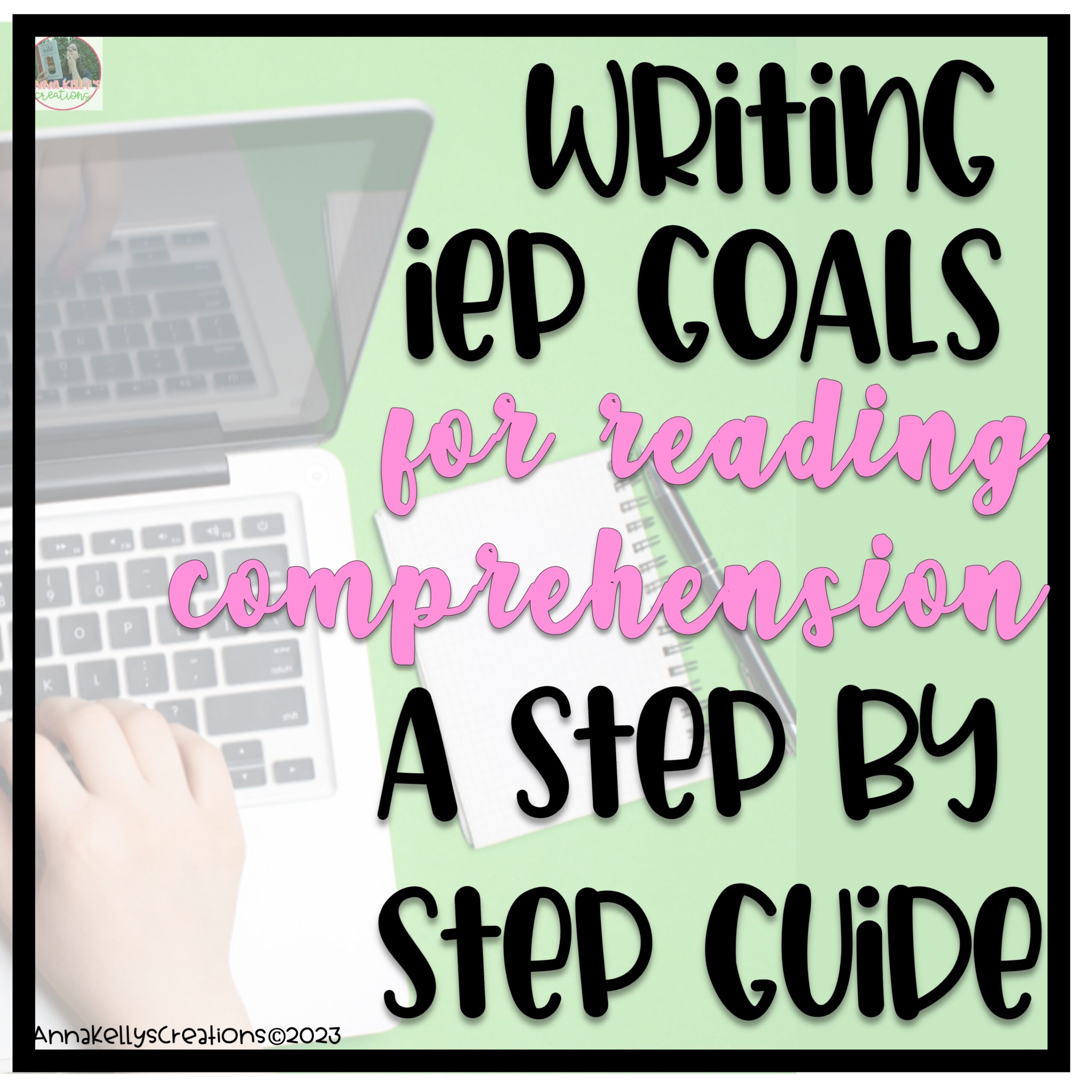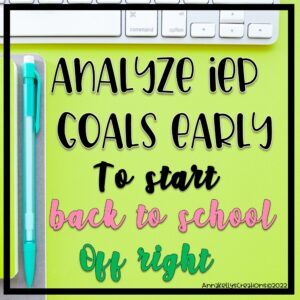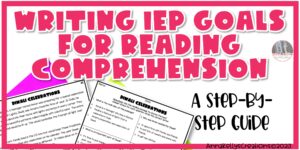
Well, the time has come…It’s time to tackle the reading comprehension goals on your student’s IEP. It’s not that reading comprehension goals for Individualized Education Programs (IEP) are hard to write per se it can just become time-consuming to gather the data. First, your student has to read passages and then answer questions. Then you have to score them and decide “do they need to do another one?”. The student gets bored or tired of doing this task and you wait around for the data. I am going to provide you with the steps I use to hopefully save you and your student a little bit of stress.
Step 1: Find your student’s reading comprehension grade level 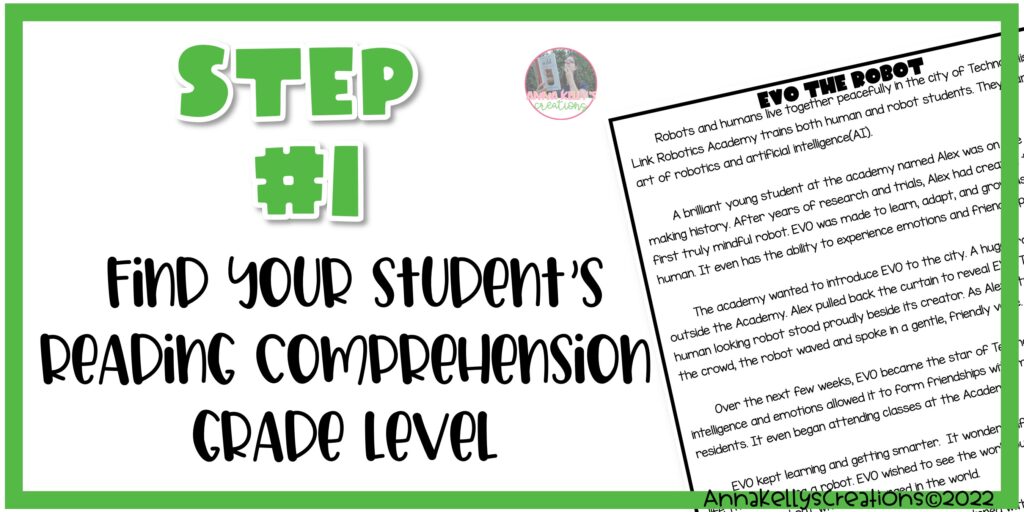
This is the most time-consuming step. We may as well get it over with first! There are many tools that can be used for this step. If your school has a standard reading assessment like STAR or AIMsweb these are great places to start. Use the data from them to find your student’s current instructional reading comprehension grade level. If your school does not have one of these assessments another great tool to use is a Reading Inventory. These will give you a grade level and areas of strengths and weaknesses for your student. A final idea is to find comprehension reading passages and question probes. I have some already made for you here. Start on the grade level you feel your student is working at. If they answer the questions with 80% accuracy or higher give them the next grade level up. If they answer the questions with 65% or lower give them the next grade level down. Continue until you find your student’s instructional level.
Tip: make sure to use both fiction and nonfiction probes.

Step 2: Find your student’s strengths and weaknesses
In this step, you analyze your student’s assessments. Look for patterns, which type of questions to they most commonly get incorrect. What type of questions do they answer correctly most of the time? All of this is great information to add to the Present Levels section of the reading comprehension goal. Find 3 or 4 areas that your student needs to work on these will be your objectives. Most commonly my students struggled with the main idea, making inferences, context clues, and text evidence.
Collect data quickly and time efficiently by giving reading comprehension probes that have the same types of questions. I have ready-to-go probes that are streamlined to ask the same type of question on each. Check out the freebie in my store!
Step 3: Write the reading comprehension IEP goal
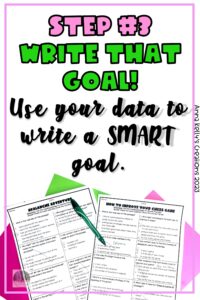
I know I know you’ve heard it before but just giving a gentle reminder….When it comes to writing IEP goals, SMART is the key. That stands for Specific, Measurable, Attainable, Relevant, and Time-bound. Using this model helps to ensure that your goals are realistic and achievable, and that progress can be measured along the way.
For reading comprehension goals, you can use the SMART model to create objectives that focus on specific skills, such as identifying main ideas or making inferences, and that are measurable through assessments or observations. By setting attainable goals, you’re more likely to see dramatic improvements in your students’ reading comprehension skills.
Example: Student is currently at an instructional level of 3rd grade.
By the end of the IEP year when given a 4th-grade level fiction or nonfiction reading passage Student will be able to answer comprehension questions with 80% accuracy on 5 out of 5 trials. Measured by assessments.
Step 4: Write the Objectives – Focus on a Few Key Skills at a Time

“Oh my goodness my student needs help in all areas of reading comprehension!” It can be tempting to create goals that address every aspect of reading comprehension at once. However, this can be overwhelming for both you and your student, and may not result in meaningful progress.
Instead, focus on a few skills at a time, based on your student’s assessment results. As stated in Step 2 choose three or four of the most needed areas. This will allow you to maximize your intervention time and will help your student feel more successful. By giving your student just a few areas to work on they will start to see their progress and become more motivated.
Each area can be an objective.
Example: Student is currently at an instructional level of 3rd grade.
Objective 1: By the end of the IEP year when given a 4th grade level fiction or nonfiction reading passage Student will be able to answer inferential questions with 4 out of 5 correct on 3 out of 3 trials.
Objective 2: By the end of the IEP year when given a 4th grade level fiction or nonfiction reading passage Student will be able to answer context clue questions with 4 out of 5 correct on 3 out of 3 trials.
Objective 3: By the end of the IEP year when given a 4th grade level fiction or nonfiction reading passage Student will be able to answer main idea questions with 4 out of 5 correct on 3 out of 3 trials.
Step 5. Celebrate
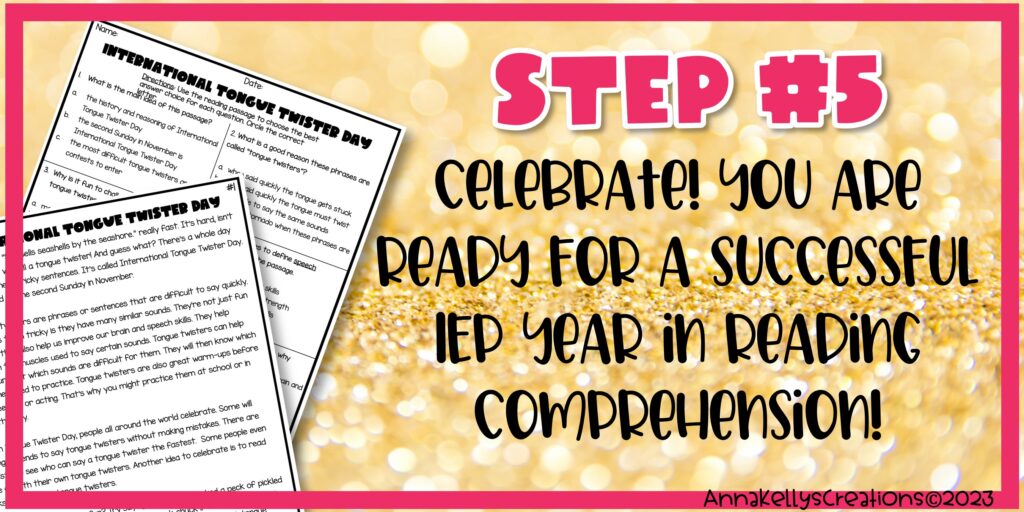
And there you have it your reading comprehension IEP goal is written! That wasn’t so bad, was it? Your student is ready for a successful IEP year in reading comprehension.
Finally, it’s important to remember that IEP goals are not set in stone. As your student makes progress and develops new skills, you may need to revisit or revise their goals to continue challenging them and helping them grow.
Regularly checking in on your student’s progress and adjusting goals as needed will help you maximize your intervention time and ensure that your student is always moving forward.
So the next time you sit down to write reading comprehension IEP goals, don’t be intimidated. Remember these tips, and you’ll be well on your way to creating goals that make a real difference in your student’s lives. Happy goal-setting!

What is the most daunting part of IEP goal writing for you? Share in the comments below.

